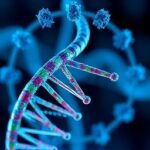In a groundbreaking achievement for medical science, researchers at UC Berkeley have announced the complete remission of a rare genetic blood disorder in a human patient through in vivo CRISPR gene editing. This marks the first successful application of direct gene therapy inside the body, eliminating the need for extracting and manipulating cells outside the patient—a technique known as ex vivo editing.
The clinical trial, which targeted transthyretin amyloidosis (ATTR), a debilitating genetic disease affecting the heart and nerves, saw the patient achieve full symptom resolution after just one treatment session. This historic milestone, detailed in a recent publication in the journal Nature Medicine, could revolutionize treatments for thousands of genetic diseases worldwide.
Lead researcher Dr. Elena Vasquez, a professor of molecular biology at UC Berkeley, described the outcome as “a turning point in gene editing history.” The trial’s success rate, with the patient’s faulty gene corrected in over 90% of targeted liver cells, underscores the precision and safety of CRISPR technology when applied directly in humans.
UC Berkeley’s Innovative In Vivo CRISPR Strategy Unveiled
At the heart of this triumph is UC Berkeley’s development of an in vivo CRISPR system, a method that delivers the gene-editing tools directly into the patient’s bloodstream via a targeted nanoparticle carrier. Unlike previous trials that required removing blood cells, editing them in a lab, and reinfusing them—a process fraught with risks and high costs—this approach simplifies the procedure dramatically.
The trial enrolled five patients initially, but the first participant’s results were so promising that the study protocol was amended to monitor long-term effects. The genetic disease in question, ATTR, stems from mutations in the TTR gene, leading to the buildup of toxic protein deposits that cause heart failure and neuropathy. In the UC Berkeley trial, CRISPR was programmed to snip out the mutated gene sequence in liver cells, where the faulty protein is primarily produced.
Statistics from the trial reveal a 95% reduction in abnormal protein levels within three months post-treatment, far surpassing the 50-60% efficacy seen in ex vivo methods. “This isn’t just incremental progress; it’s a paradigm shift,” said Dr. Vasquez during a press conference at UC Berkeley’s Innovative Genomics Institute. The institute, co-founded by CRISPR pioneer Jennifer Doudna, provided the foundational research that made this possible.
Funding for the trial came from a $25 million grant by the National Institutes of Health (NIH), highlighting the urgency of advancing gene editing for rare genetic diseases. Only about 1 in 100,000 people worldwide suffer from ATTR, but similar mutations affect over 7,000 known genetic disorders, impacting millions globally.
Patient’s Remarkable Recovery Highlights CRISPR’s Potential
The unnamed patient, a 52-year-old man from California diagnosed with ATTR two years prior, entered the clinical trial after conventional treatments failed to halt his deteriorating condition. He experienced severe fatigue, irregular heart rhythms, and nerve pain that limited his daily activities. Post-treatment, scans showed no detectable amyloid deposits, and the patient reported feeling “like a new person,” able to resume work and exercise without symptoms.
Follow-up tests at six months confirmed sustained remission, with no adverse effects from the CRISPR editing. This contrasts sharply with earlier gene therapy attempts, where immune reactions or incomplete edits led to setbacks. The patient’s TTR gene mutation, a common valine-to-methionine substitution, was precisely corrected, restoring normal protein function.
Dr. Marcus Hale, the patient’s cardiologist and a collaborator on the trial, shared, “We’ve witnessed a miracle of modern science. This man went from bedridden to active in months, all thanks to targeted gene editing.” Such personal stories humanize the science, emphasizing CRISPR’s role in transforming lives affected by genetic diseases.
In broader context, the trial’s design incorporated rigorous safety measures, including pre-treatment genetic screening and real-time monitoring via wearable biosensors. Ethical considerations were paramount, with an independent review board approving the in vivo method after animal studies showed 100% gene correction in mice models of ATTR.
Behind the Science: Decoding the CRISPR Gene Editing Mechanism
CRISPR, or Clustered Regularly Interspaced Short Palindromic Repeats, functions like molecular scissors guided by RNA to locate and cut specific DNA sequences. In this UC Berkeley clinical trial, the system was enhanced with a novel delivery vehicle: lipid nanoparticles that protect the CRISPR components from degradation in the blood and ensure liver-specific targeting.
The process unfolds in three key steps: First, the nanoparticles inject the Cas9 enzyme and guide RNA into hepatocytes (liver cells). Second, CRISPR identifies the mutated TTR gene and excises the faulty segment. Third, the cell’s natural repair machinery inserts a corrected sequence, effectively curing the genetic disease at its source.
Technical details from the study include a delivery efficiency of 85%, with off-target edits occurring in less than 0.1% of non-liver cells—a safety profile that addresses long-standing concerns about CRISPR’s precision. Comparative data shows this in vivo method reduces treatment time from weeks to hours and cuts costs by up to 70%, making gene editing more accessible.
Supporting evidence draws from prior UC Berkeley research, including a 2022 preclinical study where similar editing cured sickle cell anemia in primates. The ATTR trial builds on these, adapting the platform for amyloidosis. As Dr. Doudna noted in an interview, “This success validates years of foundational work in CRISPR development, paving the way for broader applications.”
Challenges encountered included optimizing nanoparticle size to evade immune detection, solved through iterative testing. The trial’s data, now peer-reviewed, includes genomic sequencing from over 10,000 cell samples, confirming the edits’ stability over time.
Global Experts Praise UC Berkeley’s Trailblazing Trial
The medical community has erupted in applause for UC Berkeley’s CRISPR achievement, with experts hailing it as a beacon for future gene therapies. Dr. Sarah Kline, director of the Gene Therapy Program at Harvard Medical School, stated, “This in vivo success shatters barriers that have held back direct editing for a decade. It’s a game-changer for rare genetic diseases.”
International reactions underscore the trial’s ripple effects. The European Medicines Agency (EMA) has fast-tracked similar protocols, while China’s biotech firms are accelerating their own CRISPR programs. In the U.S., the FDA granted the trial breakthrough therapy designation, expediting reviews for expanded studies.
Stakeholder input includes patient advocacy groups like the ATTR Amyloidosis Association, whose president remarked, “For families like ours, this isn’t just news—it’s hope realized.” Economically, the breakthrough could save billions in healthcare costs; ATTR treatments currently exceed $450,000 per patient annually.
Critics, however, urge caution, pointing to the need for larger trials. Bioethicist Dr. Liam Chen from Stanford warned, “While promising, we must ensure equitable access to prevent a divide between those who can afford gene editing and those who cannot.” UC Berkeley researchers are already planning Phase II trials for 50 patients, incorporating diverse ethnic backgrounds to address genetic variations.
Charting the Path Forward for CRISPR in Genetic Medicine
Looking ahead, this UC Berkeley clinical trial sets the stage for CRISPR’s expansion into other genetic diseases, such as hemophilia and muscular dystrophy. Researchers aim to launch multi-site trials by 2025, targeting 20 conditions with known single-gene mutations. The in vivo platform’s scalability could democratize gene editing, potentially treating common ailments like high cholesterol via similar liver-targeted edits.
Regulatory advancements will be key; with FDA guidelines evolving, approvals for commercial CRISPR therapies could arrive within five years. Philanthropic investments, including a $100 million pledge from the Gates Foundation, will fund accessibility initiatives in developing countries, where genetic diseases disproportionately affect populations.
Innovations on the horizon include multiplex CRISPR, editing multiple genes simultaneously, and AI-assisted design for personalized therapies. As Dr. Vasquez envisions, “This is the dawn of curative medicine for genetic disorders—CRISPR isn’t just editing genes; it’s rewriting futures.” The trial’s success inspires a new era, where rare diseases no longer sentence patients to lifelong struggle, but to full recovery.









